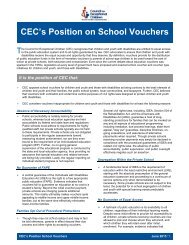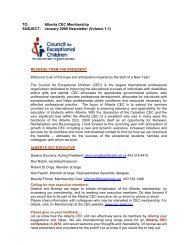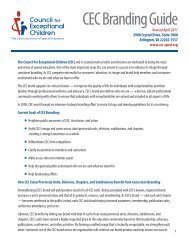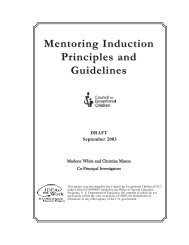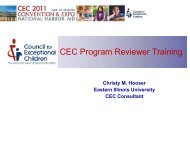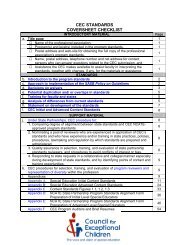What Every Must Know Special Educator - Council for Exceptional ...
What Every Must Know Special Educator - Council for Exceptional ...
What Every Must Know Special Educator - Council for Exceptional ...
You also want an ePaper? Increase the reach of your titles
YUMPU automatically turns print PDFs into web optimized ePapers that Google loves.
e appropriate; however, they should never be used<br />
without the approval of the individual to be treated,<br />
or the individual’s parents or guardians, or, in circumstances<br />
where the individual is a ward of the state, the<br />
approval of an appropriate review body be<strong>for</strong>e which<br />
the individual or his or her representatives are guaranteed<br />
all legal due-process rights.<br />
Paragraph17 - Physical Intervention<br />
The <strong>Council</strong> recognizes the right to the most effective<br />
educational strategies to be the basic educational<br />
right of each special education child. Furthermore,<br />
The <strong>Council</strong> believes that the least restrictive positive<br />
educational strategies should be used, as it relates to<br />
physical intervention, to respect the child’s dignity and<br />
personal privacy. Additionally, The <strong>Council</strong> believes<br />
that such interventions shall assure the child’s physical<br />
freedom, social interaction and individual choice. The<br />
intervention must not include procedures which cause<br />
pain or trauma. Intervention techniques must focus<br />
not only on eliminating a certain undesirable behavior,<br />
but also upon a determination of the purpose of that<br />
behavior, and the provision/instruction of a more appropriate<br />
behavior. Lastly, behavior intervention plans<br />
must be specifically described in the child’s written<br />
educational plan with agreement from the education<br />
staff, the parents and, when appropriate, the child.<br />
The <strong>Council</strong> recommends that physical intervention be<br />
used only if all the following requirements are met:<br />
a. The child’s behavior is dangerous to herself/<br />
himself or others, or the behavior is extremely<br />
detrimental to or interferes with the education or<br />
development of the child.<br />
b. Various positive rein<strong>for</strong>cement techniques have<br />
been implemented appropriately and the child<br />
has repeatedly failed to respond as documented<br />
in the child’s records.<br />
c. It is evident that withholding physical intervention<br />
would significantly impede the child’s educational<br />
progress as explicitly defined in his/her written<br />
educational plan.<br />
d. The physical intervention plan specifically will<br />
describe the intervention to be implemented, the<br />
staff to be responsible <strong>for</strong> the implementation, the<br />
process <strong>for</strong> documentation, the required training<br />
of staff and supervision of staff as it relates to the<br />
intervention and when the intervention will be<br />
replaced.<br />
260 whAt every SpeCiAl eduCAtor muSt <strong>Know</strong><br />
e. The physical intervention plan will become a part<br />
of the written educational plan.<br />
f. The physical intervention plan shall encompass<br />
the following provisions:<br />
1. A comprehensive analysis of the child’s<br />
environment including variables contributing<br />
to the inappropriate behavior.<br />
2. The plan to be developed by a team including<br />
professionals and parents/guardians, as<br />
designated by state/provisional and federal<br />
law.<br />
3. The personnel implementing the plan shall<br />
receive specific training congruent with the<br />
contents of the plan and receive ongoing<br />
supervision from individuals who ware<br />
trained and skilled in the techniques identified<br />
in the plan.<br />
4. The health and medical records of the child<br />
must be reviewed to ensure that there are<br />
no physical conditions present that would<br />
contraindicate the use of the physical<br />
intervention proposed.<br />
5. The impact of the plan on the child’s behavior<br />
must be consistently evaluated, the results<br />
documented, and the plan modified when<br />
indicated.<br />
The <strong>Council</strong> supports the following prohibitions:<br />
a. Any intervention that is designed to, or likely to,<br />
cause physical pain.<br />
b. Releasing noxious, toxic or otherwise unpleasant<br />
sprays, mists, or substances in proximity to the<br />
child’s face.<br />
c. Any intervention which denies adequate sleep,<br />
food, water, shelter, bedding, physical com<strong>for</strong>t, or<br />
access to bathroom facilities.<br />
d. Any intervention which is designed to subject,<br />
used to subject, or likely to subject the individual<br />
to verbal abuse, ridicule or humiliation, or which<br />
can be expected to cause excessive emotional<br />
trauma.<br />
e. Restrictive interventions which employ a device or<br />
material or objects that simultaneously immobilize




